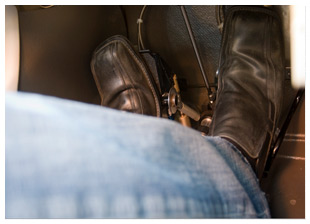Training Tips |
One small step
You absorbed those surprises, made the mental adjustment, and got on with learning to fly. (You may not have realized it at the time, but that was your first brush with the law of primacy, a concept that speaks to the power of first impressions in learning.) There were similarities, too, between aircraft and your familiar modes of ground transportation. On most single-engine aircraft, the brakes are foot-powered, although to use them correctly, you learn to apply pressure to the proper portion of the pedals, because they also control steering and rudder. Another revelation was that aircraft brakes function independently. If a taxi turn that you have initiated with nosewheel (or tailwheel) steering needs to be tightened, a touch of brake in the desired direction does the job. Mostly, however, you taxi with minimum power and the steering function, avoiding excess braking. Nosewheel steering also guides the takeoff run until rudder becomes effective; the reverse applies during a landing roll. Braking—except in aircraft with a castering nosewheel—is usually deferred until needed for exiting the runway or coming to a full stop. Most trainees master the technique quickly, but it only takes a distraction or stress to cause a misstep, with several possible consequences. Inadvertently riding the brakes during takeoff delays acceleration, reducing the safety margin on takeoff from a short runway. On any takeoff, brake pressure applied asymmetrically could induce a swerve, or a complete loss of control. On landing, touching down with a brake pedal depressed could cause directional control problems or even blow out a tire. Maintain the proper pedal pressure and position by being seated comfortably at the controls, and by adjusting your foot position on the pedals depending on the operating phase in progress (use a forward motion for steering or rudder, forward and raised to add braking). "As the airplane starts to roll forward, the pilot should assure both feet are on the rudder pedals so that the toes or balls of the feet are on the rudder portions, not on the brake portions," says Chapter 5 of the Airplane Flying Handbook. Then relax and fly with a light touch on all the controls. Training ProductsASA releases FAR/AIM seriesASA has released the 2014 edition of its FAR/AIM series on the federal aviation regulations. The series is designed for use by pilots, mechanics, and flight crews, and includes the Federal Aviation Regulations/Aeronautical Information Manual (FAR/AIM), the FAR for aviation maintenance technicians and flight crews, FAR and AIM flashcards, and flashcards for the air transport pilot. Note: Products listed have not been evaluated by ePilot editors unless otherwise noted. AOPA assumes no responsibility for products or services listed or for claims or actions by manufacturers or vendors. Final ExamQuestionYou are approaching an airport with crossing runways, 18/36 and 09/27. The wind favors Runway 18 and the tower tells you to expect landing clearance for Runway 18 on short final. The tower then clears a Boeing 757 for takeoff on Runway 27. You watch the heavy jet accelerate down Runway 27. The 757 rotates and lifts off crossing the intersection of 18/27 at about 50 feet. The tower now clears you to land on Runway 18. How will you execute the landing? AnswerWhen landing behind a larger aircraft on a crossing runway, note the aircraft's rotation point. If that point is past the intersection, continue and land prior to the intersection. If the larger aircraft rotates prior to the intersection, as it did in this scenario, avoid flight below its flight path. Abandon the approach unless a landing is ensured well before reaching the intersection. Chapter 13 of the Pilot's Handbook of Aeronautical Knowledge provides further information on avoiding wake turbulence. Got a question for our technical services staff? Contact AOPA. |
 Remember how strange it seemed to learn that your training aircraft is steered on the ground with foot pedals, and the throttle is worked by hand?
Remember how strange it seemed to learn that your training aircraft is steered on the ground with foot pedals, and the throttle is worked by hand?

